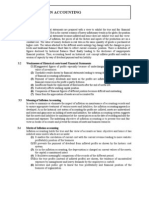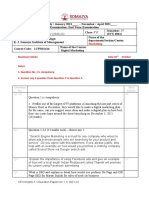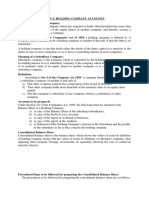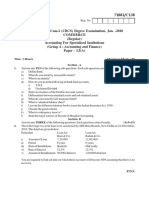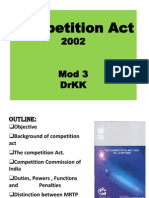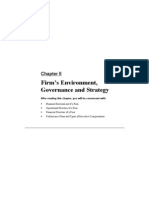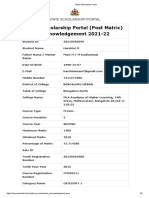SCM Solved 2
Uploaded by
Madhu kumarSCM Solved 2
Uploaded by
Madhu kumarSmt. Dr.
Mahananda B Chittawadagi
Research Guide, Bengaluru City University
Associate Professor of commerce
Activity Based Costing
(Previous year question paper sum with solutions)
(2015)
Q1. The Columbus Company produces only two products: a major computer part and cell phones. The
company uses a normal cost system and overhead costs are currently allocated using a plant-wide
overhead rate based on direct labor hours. Outside cost consultants have recommended, however, that the
company use activity based costing to charge overhead to products.
The company expects to produce 4000 computer parts & 2000 cell phones in 2014. Each
computer parts requires two direct labor hours to produce and each cell phone requires one-half hour to
produce.
The direct material and direct labor costs included in the two products are as follows:
Item Computer part (Rs.) Cell phone (Rs.)
Direct material (per unit) 3000 1700
Direct labor (per unit) 1600 400
Budgeted (estimated) total factory overhead data for 2014:
Activity Budgeted overhead (Rs.) Estimated volume level
Production setups 8000000 20 setups
Material handling 7000000 5000 1bs
Packaging and shipping 12000000 6000 boxes
Total factory overhead 27000000
Based on an analysis of the three overhead activities, it was estimated that the two products would
require these activities as follows in 2014:
Activity Computer parts Cell phones Overall totals
Production setups 5 setups 15 setups 20 setups
Material handling 1000(1bs) 4000 (1bs) 5000 (1bs)
Packaging and shipping 4000 (boxes) 2000 (boxes) 6000 (boxes)
Required:
a) Calculate the cost of each product using a plant wide rate based on direct labor hours.
b) Calculate the activity cost rates for (a) setups, (b) material handling and (c) packaging and
shipping.
c) Cost out the two products using an activity-based costing system.
Solution:
Direct labor hour rate = Total fixed overhead
Total direct labor hour
= 27000000
Strategic Cost Management -1 Page 1
Smt. Dr. Mahananda B Chittawadagi
Research Guide, Bengaluru City University
Associate Professor of commerce
9000
= Rs. 3000 per direct labor hr rate.
Total Direct labor hour = (4000*2) + (2000*0.5)
= 8000 + 1000 = 9000
Step 1- Calculation of cost of each product using a Pant-wide rate based on direct labor hour:
Particulars Computer (per unit) Cell phone (per unit)
Direct Material 3000 1700
Direct Labor 1600 400
Prime cost 4600 2100
(+) Overheads cost (3000*2) 6000 -
(3000*0.5) - 1500
Total cost per units (A) 10600 3600
Units (B) 4000 2000
Total cost (A*B) 42400000 7200000
Step 2- Calculation of activity based cost rates/statement showing overhead absorption:
Name of O/H as cost Budgeted Budgeted Calculation b/d Rates of
pool O/H Rs. volume of cost drivers
cost driver
Production setups 8000000 20 8000000/20 400000
Material handling 7000000 5000 7000000/5000 1400
Packaging and shipping 12000000 6000 12000000/6000 2000
Step 3 – Calculation of cost of the two product using ABC system
Particulars Computer Cell phone
Direct Material 12000000 3400000
(3000*4000) (1700*2000)
Direct Labor 6400000 800000
(1600*4000) (400*2000)
Prime cost 18400000 4200000
Production setups 2000000 6000000
(5*400000) (15*400000)
Material handling 1400000 5600000
(1400*1000) (1400*4000)
Packaging and shipping 8000000 4000000
(2000*4000) (2000*2000)
Total cost A 29800000 19800000
Strategic Cost Management -1 Page 2
Smt. Dr. Mahananda B Chittawadagi
Research Guide, Bengaluru City University
Associate Professor of commerce
Units B 4000 2000
Total cost per unit A/B 7450 9900
Step 4 – Statement showing cost distortion (different):
Particulars Computer Cell phone
Per unit cost:
Traditional method 10600 3600
ABC method 7450 9900
3150 (6300)
Therefore, Computer over observed as per traditional method.
Cell phone under observed as per traditional method.
(2017)
Q2. Alpha limited has decided to analyze the profitability of its five new customers. It buys bottled water
at Rs.90 per
Care and sells to retail customers at a list price of Rs.108 per care. The data pertaining to five
customers are:
Customers
A B C D E
Cares sold 4680 19688 136800 71550 8775
List selling price Rs. 108 Rs. 108 Rs. 108 Rs. 108 Rs. 108
Actual selling price Rs. 108 Rs.106.20 Rs. 99 Rs. 104.40 Rs. 97.20
Number of purchase orders 15 25 30 25 30
Number of customer visits 2 3 6 2 3
Number of deliveries 10 30 60 40 20
Kilometers travelled per delivery 20 6 5 10 30
Number of expedited deliveries 0 0 0 0 1
Its five activities and their cost drivers are:
Activity Cost driver rate (Rs.)
Order taking 750 per purchase order
Customer visits 600 per customer visit
Deliveries 5.75
Product handling 3.75 per care sold
Expedited deliveries 2.250 per expedited delivery
Required:
a) Compute the customer level operating income of each of five retail customers now being
examined (A, B, C, D and E) comment on the results.
Strategic Cost Management -1 Page 3
Smt. Dr. Mahananda B Chittawadagi
Research Guide, Bengaluru City University
Associate Professor of commerce
b) What insights are gained by reporting both the list selling price and the actual selling price for
each customer?
c) What factors Alpha limited should consider in deciding whether to drop one or more of five
customers?
Solution:
Statement showing customer level operating income
Particulars A B C D E
Cares sold 4680 19688 136800 71550 8775
Revenue as per list price 505440 2126304 14774400 7727400 947700
(108*cares sold)
(-) discount (BIF) 0 35438 1231200 257580 94770
Revenue at actual price 505440 2090866 13543200 7469820 852930
(-) cost of goods sold 421200 1771920 12312000 6439500 789750
(purchase @ Rs. 90)
Gross margin (A) 84240 318946 12312000 1030320 63180
Customer level operating
activities cost :-
Order taking @ 750 11250 18750 22500 18750 22500
(15*750) (25*750) (30*750) (25*750) (30*750)
Customer units @ Rs. 1200 1800 3600 1200 1800
600 (600*2) (300*3) (600*6) (600*2) (600*3)
Deliveries @ 5.75 per 1150 1035 1725 2300 3450
km (5.75*10*20) (5.75*30*6) (5.75*60*5) (5.75*40*10) (5.75*20*30)
travelled
Product handling 17550 73830 513000 268312 32906
@ 3.75 per care sold (3.75*4680) (3.75*19688) (3.75*136800) (3.75*71550) (3.75*8775)
Expedited deliveries 0 0 0 0 2250
@2.250 (2250*0) (2250*0) (2250*0) (2250*0) (2250*1)
Total cost (B) 31150 95415 540825 290562 62906
Customer level operating 53090 223531 690375 739758 274
level (A-B)
Customer D is the most profitable customer of Rs. 739757 customer E is less profitable.
(2018)
Q3. XYZ Company ltd. has six departments, A, B, C, D, E and F, and has allocation manufacturing
overhead using one cost pool based on direct labor hours. The accounting staff has provided the following
estimates applicable to traditional and ABC allocation of manufacturing costs for 2004:
Cost (Rs.) Allocation Base Activity
Set-ups 16500 No. of set-up 250 setups
Strategic Cost Management -1 Page 4
Smt. Dr. Mahananda B Chittawadagi
Research Guide, Bengaluru City University
Associate Professor of commerce
Quality control 24000 No. of inspector 400 inspections
Fabrication 36000 Production runs 3600 runs
Direct labor 90000 Direct labor hours 4500 labor hours
Management is assessing if ABC should be used, and has determined that Department B used the
following: 24 setps, 60 inspections, 900 production runs and 900 direct labor hours during 2004.
You are required:
i.Determine how much overhead cost is allocated to Dept. B using Traditional allocation.
ii.Using ABC, how much overhead cost is allocated to Dept. B?
iii.Which items are cost drivers?
iv.Which items are cost objects?
Solution:
i.Computation of overhead cost allocated to dept B using traditional allocation:
Direct labor hour rates = Total overheads
Direct labor hours
= 166500 = 37 Labor hour rate
4500
Overhead cost = Direct labor hour rate * Direct labor hours
= 37*900
= 33300
ii.Computation of overhead cost allocated to dept B using ABC:
Step 1: Computation of cost driver rates
Cost Pool Cost Cost driver Volume Calculation Cost driver
rate
Direct labor 90000 Direct labor hour 4500 90000/4500 20
Set-ups 16500 No. of set-up 250 16500/250 66
Quality control 24000 No. of inspector 400 24000/400 60
Fabrication 36000 No. of production 3600 36000/3600 10
runs
Step 2: Computation of overhead cost
Activity Calculation Overhead absorbed
Direct labor 20*900 18000
Set-ups 60*60 3600
Quality control 10*900 9000
Fabrication 66*24 1584
32184
iii.Cost drivers: No. of setups, No. of inspections, Production runs, Direct labor hours.
iv.Cost object: Set-ups, Inspection, Production runs, Direct labor hour.
Strategic Cost Management -1 Page 5
Smt. Dr. Mahananda B Chittawadagi
Research Guide, Bengaluru City University
Associate Professor of commerce
Q4. Fire Field Ltd., makes a single product- a fire resistant commercial filing cabinet – that it sells to
office furniture distributors. The company has a simple ABC system that it uses for internal decision
making. The company has two overhead departments whose costs are listed below:
Manufactured overhead Rs. 500000
Selling & administrative overhead Rs. 300000
Total overhead cost Rs. 800000
The company’s activity based costing system has the following activity cost pools and activity
measures:
Activity cost pool Activity Measures
Assembling units Number of units
Processing orders Number of orders
Supporting customers Number of customers
Other Not applicable
Costs assigned to the “other” activity cost pool have no activity measure; they consist of the costs of
unused capacity and organization-sustaining costs – neither of which are assigned to products, orders or
customers.
Fire field distributes the costs of manufacturing overhead and of selling and administrative overhead to
the activity cost pools based on employee interviews, the results of which are reported below:
Distribution of Resource Consumption Across activity Cost Pools
Assembling Processing Supporting Other Total
Units Orders Customers
Manufacturing 50% 35% 5% 10% 100%
overhead
Selling & 10% 45% 25% 20% 100%
administrative
overhead
Total activity 1000 units 250 orders 100 customers - -
Required:
i.Perform the first stage allocation of overhead costs to the activity cost pools.
ii.Compute activity rates for the activity cost pools.
iii.Office Mart is one of the Ferris Corporation’s customers. Last year Office Mart ordered filling cabinet
four different times. Office mart ordered a total of 80 cabinets during the years. Construct a table showing
the overhead costs of these 80 units and four orders.
Solution:
i.Statement showing allocation of overhead cost to the activity cost pools
Activity Assembly Processing Supporting Other Total
ling customers
Manufactured 50% 35% 5% 10% 500000
overhead 250000 175000 25000 50000
Selling & 10% 45% 25% 20% 300000
Strategic Cost Management -1 Page 6
Smt. Dr. Mahananda B Chittawadagi
Research Guide, Bengaluru City University
Associate Professor of commerce
administrative 30000 135000 75000 60000
overhead
Total cost 280000 310000 100000 110000 800000
ii.Computation of activity rates for activity cost pool
Activity cost Total cost Activity rate Calculation Rates
pool
Assembly 280000 1000 280000/1000 280
Processing order 310000 250 310000/250 1240
Supporting 100000 100 100000/100 10000
customer
Others 110000 0 110000/0 0
iii.Statement showing overhead cost
Particulars Calculation Cost
Assembly (280*80) 22400
Processing order (1240*4) 4960
Total 27360
(2019)
Q5. A company produces four products, viz. P, Q, R & S. The data relating to production activity are as
under.
Product Quantity of Material Direct labor Machine Direct labor
Production cost/unit (Rs.) hours/unit hours/unit cost /unit (Rs.)
P 1000 10 1 0.50 6
Q 10000 10 1 0.50 6
R 1200 32 4 2.00 24
S 14000 34 3 3.00 18
Production overheads are as under: (Rs.)
i.Overheads applicable to machine oriented activity 149700
ii.Overheads relating to ordering materials 7680
iii.Set up costs 17400
iv.Administration overheads for spare parts 34380
v.Material handling costs 30294
The following further information have been compiled.
Strategic Cost Management -1 Page 7
Smt. Dr. Mahananda B Chittawadagi
Research Guide, Bengaluru City University
Associate Professor of commerce
Product No. of set ups No. of materials No. of times No. of spare
Orders Materials Parts
handled
P 3 3 6 6
Q 18 12 30 15
R 5 3 9 3
S 24 12 36 12
Required:
1. Select a suitable cost driver for each item of overhead expense and calculate the cost per unit of
cost driver.
2. Using the concept of activity based costing. Compute the factory cost per unit of each product.
Solution:
Step 1 – Statement showing rates of cost drivers
Name of O/H as cost Budgeted Name of cost driver Budgeted Calculation Rates of
pool O/H Rs. volume of b/d cost
cost driver drivers
Material oriented 149700 Machine hours 1 49900 149700/49900 03
Ordering materials 7680 No. of orders for 30 7680/30 256
materials 2
Set-up costs 17400 No. of set ups 3 50 17400/50 348
Administration 34380 No. of spare parts 4 36 34380/36 955
overheads for spare parts
Material handling 30294 No. of times 81 30294/81 374
Materials handled 5
Working note:
Rates of cost drivers = Overheads applicable to machine oriented activities
Machine hours
1. Calculation of machine hours = Units * No. of machine hrs per unit
P = 1000 * 0.5 = 500
Q = 10000 * 0.5 = 5000
R = 1200 * 2.00 = 2400
S = 14000 * 3.00 = 42000
Total number of machine hours = 500 + 5000 + 2400 + 42000 = 49900 hrs.
2. Calculation of number of materials orders
= P + Q + R + S = 3 + 12 + 3 + 12 = 30
3. Calculation of number of setups
= P + Q + R + S = 3 + 18 + 5 + 24 = 50
Strategic Cost Management -1 Page 8
Smt. Dr. Mahananda B Chittawadagi
Research Guide, Bengaluru City University
Associate Professor of commerce
4. Calculation of number of spare parts
= P + Q + R + S = 6 + 15+ 3+ 12 =36
5. Calculation of number of times materials handled
= P + Q + R + S = 6 + 30 + 9 + 36 = 81
Step 2 – Statement showing overhead absorption by products P, Q, R & S
Name of cost Rates Quantity volume O/H absorption in (Rs.) Total
drivers of cost O/H in
drivers P Q R S P Q R S (Rs.)
in
(Rs.)
Machine hours 03 500 500 240 42000 1500 15000 7200 1236000 149700
No. of orders for 256 3 12 3 12 768 3072 768 3072 7680
Materials
No. of set ups 348 3 18 5 24 1044 6264 1740 8352 17400
No. of spare 955 6 15 3 12 5730 14325 2865 11460 34380
parts
No. of times 374 6 30 9 36 2244 11220 3366 13464 30294
Materials
handled
Step 3 – Statement showing cost per unit
P – 1000 Q – 10000 R – 1200 S – 14000
Material cost 10 10 32 34
Labor cost 6 6 24 18
Prime cost 16 16 56 52
(+) Overheads
Material oriented 1.5 1.5 6 9
(1500/1000) (15000/10000) (7200/1200) (126000/14000)
Ordering materials 0.768 0.31 0.64 0.22
(768/1000) (3072/10000) (768/1200) (3072/14000)
Set-up costs 1.044 0.63 1.45 0.60
(1044/1000) (6264/10000) (1740/1200) (8352/14000)
Administration 5.730 1.43 2.39 0.82
overheads for spare parts (5730/1000) (14325/10000) (2865/1200) (11460/14000)
Material handling 2.244 1.12 2.81 0.96
(2244/1000) (11220/10000) (3366/1200) (13464/14000)
Cost per unit 27.29 20.99 69.29 63.60
Strategic Cost Management -1 Page 9
Smt. Dr. Mahananda B Chittawadagi
Research Guide, Bengaluru City University
Associate Professor of commerce
(2020)
Q6. The following are the data relating to Godrej Company:
Particulars P Q R Total
Production and Sales (units) 60000 40000 16000
Raw material usage in units 10 10 22
Raw material cost Rs. 50 Rs. 40 Rs. 22 2276000
Direct labor hours 2.5 4 2 342000
Machine hours 2.5 2 4 294000
Direct labor costs Rs. 16 Rs. 24 Rs. 12
No. of production runs 6 14 40 60
No. of deliveries 18 6 40 64
No. of receipts 60 140 880 1080
No. of production orders 30 20 50 100
Overheads:
Set up 60000
Machines 1520000
Receiving 870000
Packing 500000
Engineering 746000
The company operates a Just in Time inventory policy and received each Component once per production
run.
Compute:
a) The product cost based on direct labor hour recovery rate of overheads
b) The product cost using ABC.
Solution:
a) Direct labor hour rate = Total overhead
Total Direct labor hour
= 3696000 = 10.81 direct labor hour rate
342000
Computation of overhead cost under traditional method
Particulars P Q R
Raw material cost per unit 50 40 22
Direct labor cost per unit 16 24 12
Prime cost 66 64 34
(+) Overheads 27.025 43.24 21.62
(2.5*10.81) (4*10.81) (2*10.81)
Total cost per unit 93.025 107.24 55.62
No. of units 60000 40000 16000
Total cost 5581500 4289600 889920
b) Computation of product cost using ABC
Strategic Cost Management -1 Page 10
Smt. Dr. Mahananda B Chittawadagi
Research Guide, Bengaluru City University
Associate Professor of commerce
Step 1: Computation of cost driver rate
Cost pool Budgeted Cost Driver Budgeted Calculation Rate per
overhead volume cost
Set up 60000 No. of production runs 60 60000/60 1000
Machine 1520000 Machine hours 294000 1520000/294000 5.17
Receiving 870000 No. of receipts 1080 870000/1080 805.55
Packing 500000 No. of deliveries 64 500000/64 7812.5
Engineering 746000 No. of production orders 100 746000/100 7460
Step 2: Computation of product cost
Particulars P 60000 Q 40000 R 16000
Total Per Total Per Total Per unit
unit unit
Raw material 3000000 50 1600000 40 352000 22
Direct labor 960000 16 960000 24 192000 12
Prime cost 3960000 66 2560000 64 544000 34
(+) Overheads
Set up 6000 0.1 14000 0.35 40000 2.5
(1000*6) (1000*14) (1000*40)
Machine 775500 12.93 413600 10.34 330880 20.68
(5.17*2.5*60000) (5.17*2*40000) (5.17*4*16000)
Receiving 48333 0.81 112777 2.82 708884 44.30
(805.55*60) (805.55*140) (805.55*880)
Packing 140625 2.34 46875 1.17 312500 19.53
(7812.5*18) (7812.5*6) (7812.5*40)
Engineering 223800 3.73 149200 3.73 373000 23.31
(7460*30) (7460*20) (7460*50)
Total cost & 5154258 85.91 3296452 82.41 2309264 144.329
per unit
Strategic Cost Management -1 Page 11
You might also like
- Northeastern University Department of Economics100% (4)Northeastern University Department of Economics3 pages
- Inflation Accounting Environment Accounting and ResponsibilNo ratings yetInflation Accounting Environment Accounting and Responsibil17 pages
- Baf Sem Vi Sample Multiple Choice Questions100% (1)Baf Sem Vi Sample Multiple Choice Questions26 pages
- Unit 5: Holding Company Accounts Meaning of A Holding CompanyNo ratings yetUnit 5: Holding Company Accounts Meaning of A Holding Company7 pages
- Commerce (Regular) Accounting For Specialised Institutions (Group A: Accounting and Finance) Paper - 3.5 (A)No ratings yetCommerce (Regular) Accounting For Specialised Institutions (Group A: Accounting and Finance) Paper - 3.5 (A)4 pages
- Dividend Policy: J. K. Shah Classes Cs Executive - Finanical ManagementNo ratings yetDividend Policy: J. K. Shah Classes Cs Executive - Finanical Management5 pages
- UNIT-4-Choice of Business Strategies: Understanding The ToolNo ratings yetUNIT-4-Choice of Business Strategies: Understanding The Tool12 pages
- MCQ - Income Under The Head Salary by CA Kishan KumarNo ratings yetMCQ - Income Under The Head Salary by CA Kishan Kumar16 pages
- UCM - 54 Income Tax Law and Practice I PDF100% (1)UCM - 54 Income Tax Law and Practice I PDF90 pages
- Business Economics SEM-IV Question Bank Regular Examination PDFNo ratings yetBusiness Economics SEM-IV Question Bank Regular Examination PDF13 pages
- Financial Literacy PYQ+10years Top Repeated Questions by Abhishek PatelNo ratings yetFinancial Literacy PYQ+10years Top Repeated Questions by Abhishek Patel8 pages
- International Liquidity and Reserve Problems50% (2)International Liquidity and Reserve Problems34 pages
- Financial Education and Investment Awareness Two and MCQ PDFNo ratings yetFinancial Education and Investment Awareness Two and MCQ PDF28 pages
- Firm's Environment, Governance and Strategy: Strategic Financial ManagementNo ratings yetFirm's Environment, Governance and Strategy: Strategic Financial Management14 pages
- Bcom 4 Sem Corporate Accounting 2 21100875 Mar 2021No ratings yetBcom 4 Sem Corporate Accounting 2 21100875 Mar 20216 pages
- Corporate Accounting Pervious Year Question 2022No ratings yetCorporate Accounting Pervious Year Question 202213 pages
- Topic 2 Cost Concepts and Analysis HandoutsNo ratings yetTopic 2 Cost Concepts and Analysis Handouts5 pages
- Mcom Consolidated Seat Allocation List 02102019No ratings yetMcom Consolidated Seat Allocation List 0210201953 pages
- Role of Banks Credit in Economic Growth A Study WiNo ratings yetRole of Banks Credit in Economic Growth A Study Wi13 pages
- Indian National Calendar - Wikipedia PDFNo ratings yetIndian National Calendar - Wikipedia PDF12 pages
- 5th Week Lecture Notes .B A Hon Economics VIth Semeter Money and Financial MarketsNo ratings yet5th Week Lecture Notes .B A Hon Economics VIth Semeter Money and Financial Markets11 pages
- 5 Sem Bcom - Culture Society - Diversity PDF63% (8)5 Sem Bcom - Culture Society - Diversity PDF187 pages
- ACIL v. Logix Infratech Pvt Ltd. [NCLT, Delhi]No ratings yetACIL v. Logix Infratech Pvt Ltd. [NCLT, Delhi]2 pages
- 11th Chemistry EM 1st Mid Term Exam 2023 Original Question Paper Kallakurichi District English Medium PDF DownloadNo ratings yet11th Chemistry EM 1st Mid Term Exam 2023 Original Question Paper Kallakurichi District English Medium PDF Download2 pages
- My Personal Trading Plan: Equity Daily Income & Weekly Income100% (1)My Personal Trading Plan: Equity Daily Income & Weekly Income5 pages
- Chap 9 Foreign Exchange Rate Determination and ForecastingNo ratings yetChap 9 Foreign Exchange Rate Determination and Forecasting15 pages
- Form Work From Home (WFH) - Cost & GL Rev2No ratings yetForm Work From Home (WFH) - Cost & GL Rev24 pages
- How Patients Perceive Healthcare Services A Case of Ayub Teaching Hospital, Abbottabad - Pakistan. SERV Service QUAL QualityNo ratings yetHow Patients Perceive Healthcare Services A Case of Ayub Teaching Hospital, Abbottabad - Pakistan. SERV Service QUAL Quality9 pages
- Week 1 Sustainable Business 2122 KickoffNo ratings yetWeek 1 Sustainable Business 2122 Kickoff19 pages
- Inflation Accounting Environment Accounting and ResponsibilInflation Accounting Environment Accounting and Responsibil
- Unit 5: Holding Company Accounts Meaning of A Holding CompanyUnit 5: Holding Company Accounts Meaning of A Holding Company
- Commerce (Regular) Accounting For Specialised Institutions (Group A: Accounting and Finance) Paper - 3.5 (A)Commerce (Regular) Accounting For Specialised Institutions (Group A: Accounting and Finance) Paper - 3.5 (A)
- Dividend Policy: J. K. Shah Classes Cs Executive - Finanical ManagementDividend Policy: J. K. Shah Classes Cs Executive - Finanical Management
- UNIT-4-Choice of Business Strategies: Understanding The ToolUNIT-4-Choice of Business Strategies: Understanding The Tool
- MCQ - Income Under The Head Salary by CA Kishan KumarMCQ - Income Under The Head Salary by CA Kishan Kumar
- Business Economics SEM-IV Question Bank Regular Examination PDFBusiness Economics SEM-IV Question Bank Regular Examination PDF
- Financial Literacy PYQ+10years Top Repeated Questions by Abhishek PatelFinancial Literacy PYQ+10years Top Repeated Questions by Abhishek Patel
- Financial Education and Investment Awareness Two and MCQ PDFFinancial Education and Investment Awareness Two and MCQ PDF
- Firm's Environment, Governance and Strategy: Strategic Financial ManagementFirm's Environment, Governance and Strategy: Strategic Financial Management
- Bcom 4 Sem Corporate Accounting 2 21100875 Mar 2021Bcom 4 Sem Corporate Accounting 2 21100875 Mar 2021
- Role of Banks Credit in Economic Growth A Study WiRole of Banks Credit in Economic Growth A Study Wi
- 5th Week Lecture Notes .B A Hon Economics VIth Semeter Money and Financial Markets5th Week Lecture Notes .B A Hon Economics VIth Semeter Money and Financial Markets
- 11th Chemistry EM 1st Mid Term Exam 2023 Original Question Paper Kallakurichi District English Medium PDF Download11th Chemistry EM 1st Mid Term Exam 2023 Original Question Paper Kallakurichi District English Medium PDF Download
- My Personal Trading Plan: Equity Daily Income & Weekly IncomeMy Personal Trading Plan: Equity Daily Income & Weekly Income
- Chap 9 Foreign Exchange Rate Determination and ForecastingChap 9 Foreign Exchange Rate Determination and Forecasting
- How Patients Perceive Healthcare Services A Case of Ayub Teaching Hospital, Abbottabad - Pakistan. SERV Service QUAL QualityHow Patients Perceive Healthcare Services A Case of Ayub Teaching Hospital, Abbottabad - Pakistan. SERV Service QUAL Quality






